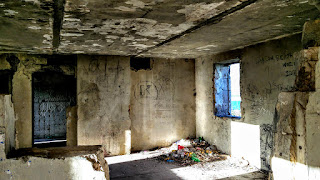Marfa Ridge
The Red Tower, Pillbox & Radar Station
The Red Tower
Saint Agatha's Tower (Maltese: Torri ta' Sant'Agata), also known as the Red Tower (Maltese: Torri l-Aħmar), Mellieħa Tower (Maltese: Torri tal-Mellieħa) or Fort Saint Agatha (Maltese: Forti Sant'Agata), is a large bastioned watchtower in Mellieħa, Malta. It was built between 1647 and 1649, as the sixth of the Lascaris towers. The tower's design is completely different from the rest of the Lascaris towers, but it is similar to the earlier Wignacourt towers. St. Agatha's Tower was the last large bastioned tower to be built in Malta.
Saint Agatha's Tower was built between November 1647 and April 1649
to a design by the architect Antonio Garsin. The structure consists of a
square tower with four corner towers. Cannon ports in the turrets gave
interlocking fields of fire commanding the base of the walls and the
gateway, with other large cannon ports in the faces of the main tower.
The outer walls are approximately four metres thick at the base and the
interior of the tower is enclosed by a barrel vaulted roof. The corner
turrets are surmounted by very characteristic fish tail crenelations. A
chapel was located within the tower.
The tower is situated in a commanding position on the crest of Marfa Ridge at the north west end of Malta, overlooking the natural harbour and potential enemy landing site of Mellieħa Bay, with clear views over to Comino and Gozo, and also eastward to the line of watchtowers along the north shore of Malta that linked it with the Knights headquarters in Valletta.
It was the Knights' primary stronghold in the west of Malta, and was
manned by a garrison of 30 men, with ammunition and supplies to
withstand a siege of 40 days. The ammunition of other fortifications in
the north of Malta, such as Aħrax Tower and Wied Musa Battery, was also stored in the tower.
Like many of the Knights' early defensive structures, St. Agatha's
Tower was strengthened during the early 18th century. A low profile
rubble wall entrenchment was built around the flanks of the tower in the form of a redan trace. Due to this, the tower also functioned as a redoubt, similar to the one at Żabbar during the French blockade.
It continued to have a military function throughout the British period, and was manned during both World Wars. From the British period it continued its military function being used as a radar station by the Armed Forces of Malta.
By the close of the 20th century St. Agatha's Tower was in poor repair,
with one turret completely missing and another turret severely damaged.
The tower was the substantially restored by Din l-Art Ħelwa starting in 1999, with restoration being completed in 2001, assisted by substantial industrial sponsorship.[4]
As part of the restoration work, the damaged turrets were replaced, the
walls and roof were rebuilt, eroded stone facing was replaced, interior
walls were scraped and painted, the original floor was uncovered, and
the interior staircase to the roof was rebuilt. Due to the extreme
unevenness of the floor, this was recently covered by a wooden surface
with glass apertures through which one can view the original slabs. The
tower is still in the care of Din l-Art Ħelwa and is open to the public.
Camouflaged British WW2 Pillbox
Not far from the Red Tower one will find a very interesting World War 2 era British Pillbox, which was camouflaged in a way to blend in with the local rubble walls. Unfortunately this pillbox seems to be abandoned and in need of repair.

































































































































































Comments
Post a Comment
Ask me Anything?